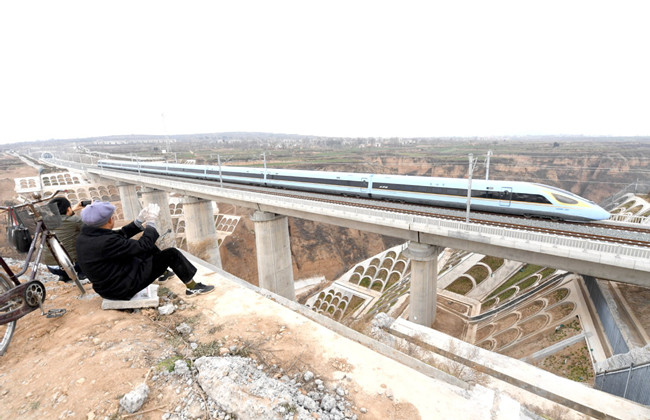
Villager Sun Zhiming (right), 78, watches a train traveling on the Yinchuan-Xi'an High-speed Railway in Qianxian county, Shaanxi province, on Saturday, as the line opens. Sun said it now only takes 30 minutes to travel by train to Xi'an, a journey that used to take him nearly 10 hours by bicycle. YUAN JINGZHI/FOR CHINA DAILY
Bullet train services on line to Xi'an will cut 11 hours from trip between capitals
Ningxia Hui autonomous region joined the national high-speed railway network on Saturday when a new bullet train service was launched linking its capital, Yinchuan, with Xi'an, capital of Shaanxi province.
The new line shortens the travel time between Yinchuan and Xi'an from 14 hours to about three. Bullet trains on the line are initially being limited to a top speed of 250 kilometers per hour, but the designers of the line have said that could be increased to 350 km/h as technology improves.
All the provincial-level regions on the Chinese mainland, with the exception of the Tibet autonomous region, are now connected to the national high-speed railway network.
Construction of the 617-km line, which has 18 stations, began in 2015. The project cost 80.5 billion yuan ($12.3 billion).
In Xi'an, the new line connects with other major high-speed railway services, including the Xi'an-Chengdu High-speed Railway to Sichuan province and the Xi'an-Datong High-speed Railway to Shanxi province, as well as the Xuzhou-Lanzhou High-speed Railway that runs between Gansu and Jiangsu provinces.
China Railway Corp, the national railway operator, said the new line is an important part of China's high-speed railway network and is also an essential poverty alleviation project.
The new line provides a convenient link between two city clusters and connects poor areas in Shaanxi and Gansu, as well as Ningxia, it said.
The company said people living along the line will benefit, and it will boost the development of western China.
Ningxia and Shaanxi also have abundant tourism resources, and the new line is expected to boost the development of that sector.
Cao Xiaolong, who lives in Yangjia village, Qingyang, Gansu, plans to open a small restaurant with his family next to the high-speed railway station in Qingyang.
Cao used to be a migrant worker but returned to his hometown to take care of his parents, who are in poor health.
He said the high-speed railway line has given him a new opportunity.
"We will see how the traffic goes (after the opening of the high-speed railway)," he said, adding that he and his wife believe it will make their lives better.
Cao formerly had a job as a construction worker near the Qingyang high-speed railway station and said he is confident about the city's future with the new line in operation.
Two other high-speed railway lines are being built in Ningxia.
One is the Zhongwei-Lanzhou High-speed Railway, which will link Zhongwei in Ningxia with Lanzhou, the capital of Gansu. The other is the Baotou-Yinchuan High-speed Railway, connecting the Inner Mongolia autonomous region and Ningxia.